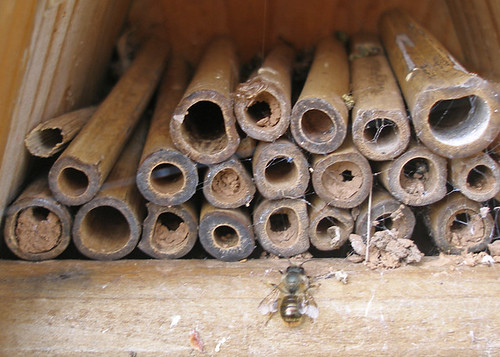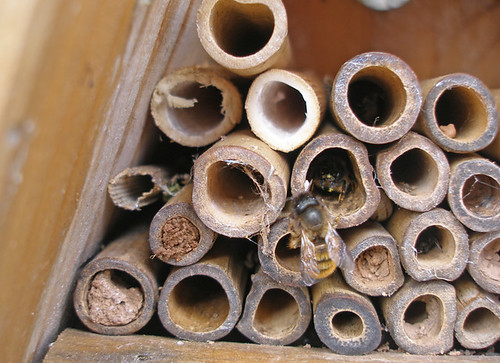The boys were hanging around aimlessly although a few did go in to investigate. Some seemed to get bored; they buzzed off for a short time but were back soon, as if they anticipated some action. There was jostling, a bit of play fighting, but on the whole they waited patiently for the girls to emerge.
This might sound like the antics of a group of teenage boys but I am actually by the Bug House in the Leechwell Garden in Totnes, delighting in the behaviour of the bees. For several weeks I have been watching, hoping that I might spot some of the occupants when they emerged this spring. I knew that solitary bees had used the many of the bamboo canes last year judging from the visible mud filling. I had also seen leaf cutter bees sealing a few of the canes with pieces of leaf, so I had high hopes.

By the third week of April many of the mud seals had been broken so I was pretty sure that some new bees had hatched and I did see a few bees hanging around the bug house. Then on the 29th April, I visited the Garden and got quite a surprise. Many bees were flying around the bug house, going in and out of the holes bored in to the wood and to a lesser extent the bamboo tubes. Some flew off but seemed to return quickly. Sometimes there seemed to some aggression between the individuals, although I could be imagining this!

The bees seemed to fall in to two groups, some were stripy, the others darker without stripes. Both seemed to have lighter “noses”, a bit like a small brush or moustache.


The next day I had another look and the same bees were there but I had the impression that the darker ones were displaying a preference for one of the bamboo tubes, hanging around and even going in to the tube for a short time.
From my photographs and given the huge number of possible solitary bees, I wouldn’t want to be definitive in identification but I would guess these are mason bees (Osmia sp.) and the stripy ones might be red mason bees. It is also likely that the bees I saw were the males who hatched first and were waiting to mate with the females when they emerged.
………………………………………………………………………………………………………………………………………………………………………………………………………………………

By May 10th the principal bees going to and fro were slightly larger, they lacked the pale nose hairs but had a distinct fringe of pale hairs around their abdomen. The abdomen itself was dark but clear striations were visible. On May 12th I had a further look and, particularly when the sun shone, there was much movement with the larger bees going in and out of the tubes and one cleaning away old mud. I assume these are mated females beginning to make nests. A few of the smaller males were also still present.
Susan Taylor told me that about the same time she had seen these bees mating.
A few days later (May 15th) it was another warm sunny day, and the bees were very busy, coming back frequently, some clearly laden with bright yellow pollen. By eye there seemed to be one kind of bee but my photographs reveal differences; again there seem to be two populations, stripy and non-stripy.

By May 16th some of the tubes had been filled and sealed neatly with mud; four days later almost all had been filled. A filled tube will contain several cells, each containing an egg with pollen and nectar. Cells created first contain fertilised eggs that will produce female bees, the later cells contain unfertilised eggs to produce males that will emerge first next spring. For more on the life cycle of these bees take a look here or here.

I can’t help but be impressed by the industry of these creatures. They work very hard transporting mud and pollen to fill the tubes to ensure their survival. They fly for a few weeks and once the nest is complete their job is finished, until the next spring. Don’t forget that all the time they are flying, they are performing an important job pollinating our trees and flowers.
For more on mason bees there are interesting posts with much better photos on A French Garden and its sister site Bees in a French Garden.
Thanks to Hazel Strange for tidying up my photos.

I’m filled with envy! I have a small hanging construction and a much larger one leaning against the garage which a friend built. Nothing so far….
LikeLike
I also have two in my garden and both are empty so far, despite the fact that the bottom of our garden is less than 100 metres from the Leechwell Bug House. We get lots of bumblebees in our garden, including my first sighting of a Tree Bumblebee yesterday, also a few honey bees but I haven’t seen many solitary bees.
LikeLike
Mason bees are fascinating to watch and they seem so industrious. I think these ones look like the red mason bees, Osmia bicornis. I think your photographs are very good and the pictures of the males are extremely clear. Amelia
LikeLike
Thanks, Amelia. Do you think the stripy and non-stripy are both Osmia bicornis? Philip
LikeLiked by 1 person